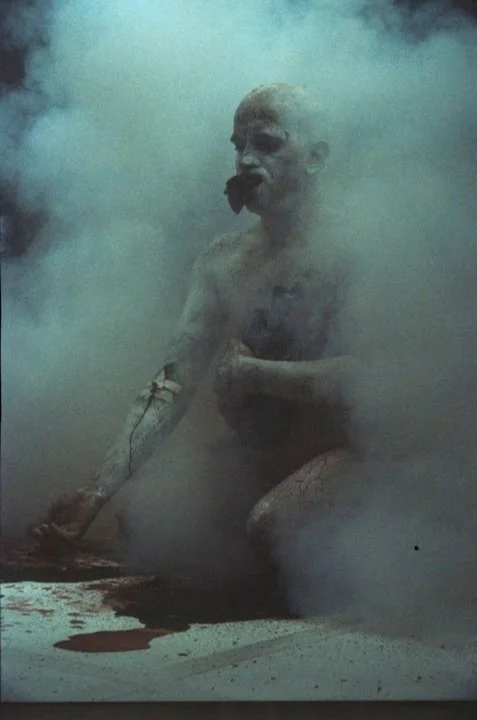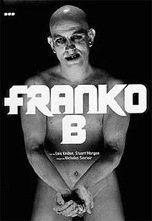Every artist is engaged in a process of psychological risk taking, testing intuition, conceptualisation and strength of purpose against the demands of the work's material production and the public response it elicits. To make actual physical injury to the artist's body an integral part of the work foregrounds the risk-taking aspect of creativity in the most challenging way, forcing artist and spectator alike to witness the most extreme manifestation of their dangerous collusion.
- Lynn MacRitchie, Performance Research
I'm Not Your Babe Part 1, ICA Theatre, May 1996. The space is dungeon dark and the music is piercing, penetrating, hypnotising. White light spotlights a man, naked, at the centre of an expectant and anxious circle of spectators. Our attention is focused on him and him alone—the mute, motionless, monochromatic body before us, that is at once all powerful and utterly helpless as a steady stream of blood drips from his arms to a pool on the floor. The highly charged presence of this body disarms us, fascinates us, repels us and seduces us. In its starkness, vulnerability, intimacy and strange beauty, this performance confronts us with a simple but compelling image—human life at its most carnal, essential and existential—flesh, blood and mystery.
This is high risk art at its purest. There is no artifice here, no pretence, no manipulation, no distance—just the overwhelming power and tension of presence and the most extreme contemporary manifestation of Lynn MacRitchie’s dangerous collusion between artist and spectator that I can think of. To experience this work is to experience the essence of performance—the total and interdependent engagement of the senses, the intellect and the emotions.
'm Not Your Babe Part 1 was part of a cumulative series of performance pieces by Franko B, that relate conceptually, if not formally, to his work in video and the plastic arts. He has said that his performance work is concerned with the creative impetus of his own personal drives and neuroses, not as therapy, but as a purifying process in pursuit of total freedom. However, what primarily connects all of these pieces is that at their centre is the abject, abstracted, bloodied and naked body of Franko B, evoking beautiful icons from images of pain and suffering and managing to make the unbearable bearable.
There has been a massive resurgence in artistic practices and critical debate around the body in the 1990s. Within this, potent and visceral live performance, where the artist's body is both the material and metaphor of the work, is again proving to be one of the most exhilarating, if appallingly misrepresented, areas of contemporary culture.
If I hear the word “freak show” again, or if one more middle aged man tells me, in response to artists such as Franko B, Ron Athey or Orlan, that they've “seen it all before in the 60s”, I swear I will not be held accountable for my actions. Although the body art of these contemporary artists may be practices cultivated in the margins and are indeed a continuum of early Performance Art practices, the contexts, conditions and intentions of their work could not possibly have been located in either the funfairs of yester—year or the galleries of the 60s. The performance work of Franko B and others is a crucially different ball game that belongs firmly to the cultural, political and social frameworks of the 90s.
The Performance Art practices that emerged from revolutions within 60s culture saw artists choosing to reject the objectification and commodification of the art object, and turning to ideas of space, time and action and their own bodies as the primary material, and possibly primary concern, of their work. For ma y artists, Performance Art opened up the possibilities of testing the limits—the limits of art, the limits of the audience and the limits of the self. One has only to consider the performance work of Marina Abramovic, Chris Burden, Joseph Beuys, the Vienna Actionists, Gina Pane and Stelarc in the 60s and 70s to understand the transgressive history of the body in relation to art and the significance of art in relation to the body.
These artists engaged with pain, suffering and endurance in their work. Sometimes as a means to personal transcendence, sometimes as a means of catharsis for society, sometimes to signify the obsolescence of the body in a technological age, and sometimes to confront us with the dark side, or just to push at the envelope. Indeed, in a grander historical and artistic picture notions of blood and art, pain and ritual are clearly not confined to the avant garde of the late twentieth century. The Performance Artists of the 60s and 70s pursued concepts of pain, blood and ritual as legitimate and unresolved terrains of artistic and social enquiry and, as we see in the work of Franko B and his contemporaries, artists are still pursuing it today.
So, in this sense, the blood and pain in Franko’s performance work can be traced to the influential legacy of European Performance Art. But for me it is the context of Franko’s practice, and what the presence of blood and pain in his work essentially represents that signifies it as such potent work about our times and of our times.
Franko’s recent work—I’m Not Your Babe Parts 1 and 2, Mama I Can't Sing Parts I, 2 and 3—represents some of the most remarkable illustrations of an area of practice generally referred to in Britain as ‘Live Art’. Essentially a hybrid child of Performance Art, experimental theatre and the new interdisciplinary practices that emerged in the late 80s and early 90s, Live Art is basically a useful, and non prescriptive, terminology for abroad range of strangely interrelated time based practices that are primarily conceptual in nature, that consider the artist as the primary material or metaphor, and that are driven by ideas rather than by a reverence to form, and which exist in real time, not being restricted by concepts of place and space. During the late 90s Live Art has proved that it is uniquely positioned to articulate and represent seemingly problematic issues through alternative strategies and that it is one of the most flexible and responsive artistic tools there is to pursue new ways of representing and responding to these shifting and uncertain times.
The Live Art arena has emerged as a significant space for immediate, intimate and challenging experiences which are in pursuit of, and being pursued by, an increasingly diverse new generation of audiences. A generation that is well—versed in the media overload of late twentieth century life, bored with the atrophy of traditional art forms, saturated with a homogenised mainstream culture, and hungry to find other media for creative expression and for engaging with more diverse intellectual and emotional risks. Live Art is writing new ‘scripts’ that are both informed by, and informing, the cultural landscape and personal agendas of a sophisticated, aware and discerning younger generation, of people who would probably never dream of going to the National Theatre or Tate Gallery but want to be provoked, tested and inspired. This is, of course, not to say that Live Art is out of bounds to anyone over 50. Far from it. But it is to suggest that, like it or not, Live Art must be both read and accepted as a genuine product of its times.
Furthermore, throughout the 90s, the influence and impact of artists emerging within the Live Art arena has extended beyond the art world and actively contributed to the shaping and defining of broader debates. Through their innovative representations of zeitgeist issues and ideas, they are not only challenging the nature, role and experience of contemporary culture, but also questioning received ways of being, seeing, thinking and doing in the modern world. As a form that draws on the artist as the primary’ material it provides a vehicle for artists to embody and represent issues and experiences against their own agendas and on their own terms——however ‘different’ or personal those terms may be. In its insistence on notions of presence, it is a raw, honest, emotionally charged and persuasive space for the rejection of received wisdoms and considerations of other possibilities. As a practice without rules, limits or expectations it can find appropriate ways to represent concepts that are marginalised and messy, and offer a sign language to say things that might otherwise be ‘unspeakable’. In this sense it is a practice that is perfectly well equipped to enter danger zones and expose the raw nerve-endings of society.
Live Art can be a space for addressing and reflecting a complex range of postmodern issues and ideas. It can problematise concepts of identity formation and hybridity and negotiate notions of sex, sexuality and the impact of AIDS. It can open up broader discourses around social dislocation and new strategies for navigating love, life and death. it can also offer a safe space for the interrogation of what many might consider to be taboos or manifestations of lives lived in extremis. As we reach the end of the century many things that were once held up as ‘truths’ are up for grabs and the postmodern world is being deconstructed and reconstructed in significant ways. As science takes the body into yet another dimension; as Western religious orthodoxies lose their role and relevance, as new technologies revolutionise human contact, as individuals embark on personal searches for fin de siécle meanings, as the body yet again becomes more transgressive and less straight and as human blood becomes as much a symbol of death as of life, questions around the body in society, and society in the body, acquire an urgency and a potency. Franko B's work, drawing on the taboos of his own blood and carnality and investigating the narrow boundary between ‘lived’ and ‘performed’ experience is at the centre of the dangerous and high—risk possibilities offered by Live Art practice.
As critical and popular interest in Franko B's work grows, this photographic study by Nicholas Sinclair is a timely and invaluable publication. I welcome it both as an extraordinary piece of work in its own right and for its sensitive tracing and exquisite framing of the uncomfortably brutal but haunting images at the centre of Franko B's work. Photography can never capture the holistic experience of performance—the total and interdependant engagement of the senses, the intellect and the emotions—and Sinclair's photographs do not try to do this. The book is neither a detatched documentation of performances, nor is it a postmodern bio-pic. Rather it is an intelligent study of an artist focussing on the images and imagery which are the key to the potency and power of Franko B's work.
publication:
related works:
-

• I'm Not Your Babe
performance (1995-1996)
-

• Mama I Can't Sing
performance (1996-2000)

